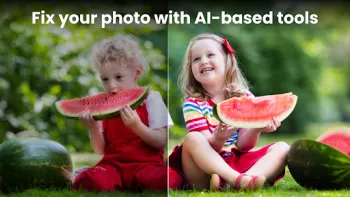Apps Home

Enhance it - AI Photo Editor
Understanding the Power of AI in Photo and Video Enhancement
Artificial Intelligence (AI) has radically transformed how we interpret, utilize, and enhance multimedia content such as photos and videos. The traditional methods of photo and video editing required a significant amount of manual work, which included minute adjustments to aspects like exposure, contrast, color balance, and resolution. However, AI-powered tools have streamlined this process, allowing users to effortlessly enhance and restore their media files with unparalleled precision and creativity. At the core of these AI applications is machine learning, specifically convolutional neural networks (CNNs) that can analyze and optimize media files at a granular level. For instance, AI applications can compensate for lighting imbalances by algorithmically adjusting a photo's exposure and illuminance, thus bringing out details lost in shadows or highlights without causing data loss in other regions of the image. Furthermore, AI technology employs advanced denoising techniques that remove digital noise without diminishing the intrinsic details of the images. This is achieved through deep learning, where the software has been trained on a vast amount of photos to distinguish between noise and edging details. Similarly, AI tools are adept at correcting motion blur in photos and videos, using algorithms designed to reverse the effects of unintentional camera movement during capture. These capabilities make AI-based multimedia enhancers like Enhance it invaluable for both amateur photographers and seasoned professionals looking to rejuvenate old, faded, or blurry images, as well as enhance newly taken photos that failed to meet expectations. AI offers these functionalities while continuously learning and evolving, ensuring media files are restored not only to their original beauty but often beyond their initial potential.
The Science Behind AI Photo Restoration
AI photo restoration is a fascinating application of machine learning that breathes new life into old and damaged photographs. The restoration process involves several computational techniques that mimic human-level pattern recognition and apply sophisticated algorithms to reconstruct damaged or missing parts of a photograph. Basic restoration includes correcting faded colors, repairing cracks, and removing dust and stains. Advanced techniques, however, recreate missing sections of a photo by contextually filling in the gaps based on the surrounding pixels' pattern and texture. This predictive capability is supported by generative adversarial networks (GANs), a form of deep learning where two neural networks—the generator and the discriminator—contest each other, leading to top-tier restoration outcomes. Another notable feature of AI restoration is colorization. An algorithm can apply color to black-and-white photographs by identifying objects, such as clothing, foliage, or the sky, and filling them in with appropriate colors that would have been prevalent at the time the photograph was taken. This colorization not only enhances the visual richness of these images but also adds a new dimension that makes historical photographs more relatable and lively. Moreover, these processes don't require the user to have specialized knowledge in editing software; instead, these AI tools provide automated and user-friendly solutions that deliver professional-grade results, bringing memories preserved in photographs back into vivid reality. Given the pace at which AI continues to advance, the results will only improve over time, making AI-enhanced photo restoration an indispensable tool for anyone looking to preserve and rejuvenate visual histories.
The Role of AI in Video Enhancement and Clarity Improvement
AI's impact on video enhancement is equally revolutionary, offering tools and algorithms that enable significant improvements in video quality and clarity. Video enhancement involves a range of processes, from adjusting color balance and exposure to correcting frame rate inconsistencies and stabilizing shaky footage. Artificial Intelligence can automate these enhancements, reducing processing time and allowing for a seamless final product. The process begins with video deblurring and sharpening, where AI algorithms detect and counteract motion blur that may have resulted from fast-moving scenes or unstable camera handling. Following deblurring, AI technologies can upscale video resolution, simulating high definition from lower-quality footage. This is achieved through super-resolution methods where AI analyzes frames individually and enhances pixel data to create smoother transitions and clearer images. Additionally, AI-powered software can refine and stabilize video by tracking and aligning frames, greatly improving the viewing experience by removing unwanted jitters and vibration artifacts. An exciting facet of AI in video enhancement is its application in real-time processing, allowing immediate adjustments and corrections during live recordings. Moreover, AI can also automate content-aware editing, intelligently suggesting cuts or transitions based on scene recognition, which is especially useful in dynamic and rapidly changing environments such as sports or live events. With the increasing ubiquity of high-definition and 4K displays, AI’s role in continuously optimizing video content ensures media playback is of the highest quality, taking full advantage of modern hardware capabilities.
Creative Spirit of AI: Transforming Moods and Styles
AI technology is not limited to the technical refinement of media but extends into artistry, deeply influencing how creative visions are expressed in photos and videos. One major innovation is the photo-to-art transformation, where AI can simulate art styles of various renowned artists, allowing users to imbue their images with unique aesthetic qualities. This is made possible via neural style transfer, a process that deconstructs the stylistic attributes of one image (an artwork, for instance) and applies it onto another (like a standard photograph), blending the content with a new art form. Through this method, an ordinary landscape photo can be rendered in the evocative swirls of Van Gogh's "Starry Night" or the stark geometric forms of Picasso’s cubism. Beyond art styles, AI tools offer filters and enhancements that adjust mood and tone, manipulating aspects such as temperature, contrast, and vibrancy to convey specific emotions or atmospheric conditions. Such intelligent alterations add depth, making scenes more dramatic, vintage-like, futuristic, or any desired portrayal. These enhancements mark a significant shift from static editing to dynamic, user-centric creation, where media can now easily reflect personal or cultural narratives. The flexibility and scope of creative possibilities through AI do not merely end with still images but also extend to video production, where similar effects can be applied to entire sequences, transforming a video’s narrative impact. As AI continues to evolve, it will undoubtedly offer even more sophisticated tools that will further democratize artistic expression, rendering traditional limitations of skill or equipment obsolete in the realm of multimedia creativity.
The Future of Multimedia Enhancements with AI Technology
The future of multimedia enhancements embarks on a trajectory heavily reliant on the continued evolution of AI technologies. As machine learning algorithms become more sophisticated, the boundaries of what is considered feasible in editing and enhancement begin to dissipate, ushering in a new era where creativity and technical precision coalesce seamlessly. Future advancements in AI will likely focus on real-time processing capabilities, enabling instantaneous enhancements without the need for post-processing intervention. This feature could empower content creators to produce and broadcast media at unprecedented quality levels while simultaneously correcting for environmental challenges like lighting or background noise. Additionally, the evolution of AI in this domain will likely expand collaborative applications, where cloud-based AI tools will allow teams around the world to co-edit and enhance media files simultaneously, leveraging vast computational resources. Furthermore, as AI models continue to assimilate contextual understanding, the potential for automatic narrative creation arises, where AI might not only enhance images and videos but also generate content directions and storylines. Enhanced interactivity might soon become a reality within video content, transforming passive consumption into active participation journeys through virtual or augmented reality landscapes enhanced by AI. Ethical considerations regarding the authenticity and manipulation of media will also be crucial, ensuring that AI-fueled edits respect the integrity of the original content and its creators. The trajectory set by AI is poised to redefine the multimedia landscape, promising enhancements that could see every photo and video achieving an exquisite blend of aesthetic brilliance and technical perfection—heretofore thought impossible. As these technologies mature, the tools offered by applications like Enhance it will remain at the forefront, providing intuitive yet powerful functionalities that redefine the boundaries of what multimedia content is capable of achieving. For instance, anyone interested in exploring these capabilities can instantly begin optimizing their media collection by using applications available on major platforms: Download for Android.
Share Your Opinion
Your Email Will Not Be Published.
All Rights Reserved © Apps Home 2025
























































Claire Mahusay
I think this is a great app. It isn't very automatic as the app Remini but for my case, this app is more suitable for me. As long as one understand...
Vi Ca
Great app to fix all my blurry photos. I often take bad photos, but I don't want to delete them. This app is extremely simple, weighs little, works...
Original Music
A great app that lets you remove noise from your pictures, scale low res images to high resolution. This app saved me a lot of pictures that were g...
Asl Explorer
It is really useful tool that can fix lot of photos. Noise was just clearly off from the photo. You can clearly see the results. But apart from tha...
Jaydeep Jaria
I was desperately searching for for this kind of app and I luckily I found "ENHANCE IT". I have few 30 years old grainy and destored pics of my lov...